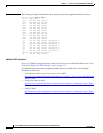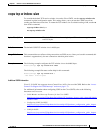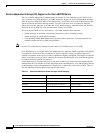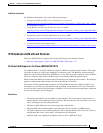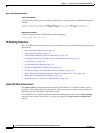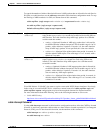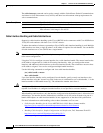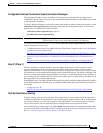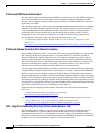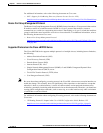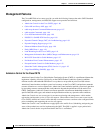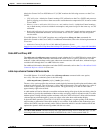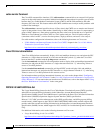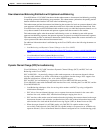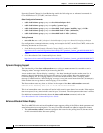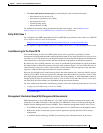
1-84
Cisco uBR7200 Series Universal Broadband Router Software Configuration Guide
OL-2239-05
Chapter1 Overview of Cisco uBR7200 Series Software
cops tcp window-size
IP Enhanced IGRP Route Authentication
The latest Interior Gateway Routing Protocol (IGRP) is an enhanced version of the IGRP developed by
Cisco. Enhanced IGRP uses the same distance vector algorithm and distance information as IGRP.
However, the convergence properties and the operating efficiency of Enhanced IGRP have improved
significantly over IGRP.
The convergence technology is based on research conducted at SRI International and employs an algorithm
referred to as the Diffusing Update Algorithm (DUAL). This algorithm guarantees loop-free operation at
every instant throughout a route computation and allows all devices involved in a topology change to
synchronize at the same time. Routers that are not affected by topology changes are not involved in
recomputations. The convergence time with DUAL rivals that of any other existing routing protocol.
For configuration information, refer to the following document on Cisco.com:
• “Configuring IP Enhanced IGRP” chapter in the Cisco IOS IP Routing Configuration Guide,
Release 12.2
http://www.cisco.com/univercd/cc/td/doc/product/software/ios122/122cgcr/fipr_c/ipcprt2/1cfeigrp.htm
IP Network Address Translation/Port Address Translation
Network Address Translation (NAT) is a mechanism for conserving registered IP addresses in large networks
and simplifying IP addressing management tasks. As its name implies, Cisco IOS NAT translates IP
addresses within private “internal” networks to “legal” IP addresses for transport over public “external”
networks (such as the Internet). Incoming traffic is translated back for delivery within the inside network.
Thus, Cisco IOS NAT allows an organization with unregistered “private” addresses to connect to the
Internet by translating those addresses into globally registered IP addresses. Cisco IOS NAT also
increases network privacy by hiding internal IP addresses from external networks.
You can configure several internal addresses with NAT to only one or a few external addresses by using a feature
called Port Address Translation (PAT) which is also referred to as “overload,” a subset of NAT functionality.
PAT uses unique source port numbers on the Inside Global IP address to distinguish between translations.
Because the port number is encoded in 16 bits, the total number could theoretically be as high as 65,536 per
IP address. PAT will attempt to preserve the original source port, if this source port is already allocated PAT
will attempt to find the first available port number starting from the beginning of the appropriate port group
0-511, 512-1023, or 1024-65535. If there is still no port available from the appropriate group and more than
one IP address is configured, PAT will move to the next IP address and try to allocate the original source port
again. This continues until it runs out of available ports and IP addresses.
For the first steps in configuring Network Address Translation, refer to the following document on
Cisco.com:
• “Configuring Network Address Translation: Getting Started
http://www.cisco.com/warp/public/556/12.html
For additional information about IP NAT and PAT, refer to the following document on Cisco.com:
• “Product Bulletin No. 1195, Cisco IOS Network Address Translation (NAT)
http://www.cisco.com/warp/public/cc/pd/iosw/ioft/ionetn/prodlit/1195_pp.htm
NAT—Support for NetMeeting Directory (Internet Locator Service—ILS)
The Cisco IOS Network Address Translation (NAT) supports the Microsoft NetMeeting directory.
Microsoft NetMeeting is a Windows-based application that enables multi user interaction and
collaboration from a user's PC over the Internet or an intranet. Support for the NetMeeting Directory
(ILS) allows connections by name from the directory built into the NetMeeting application. Destination
IP addresses do not need to be known in order for a connection to be made.



